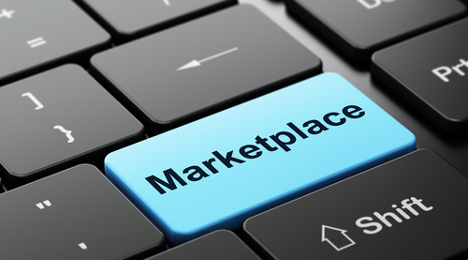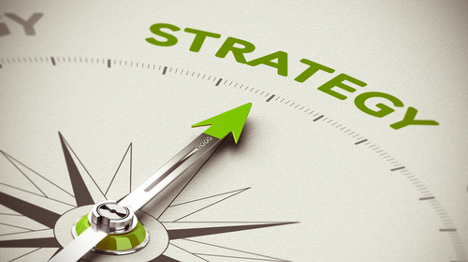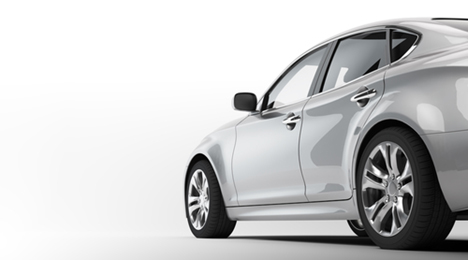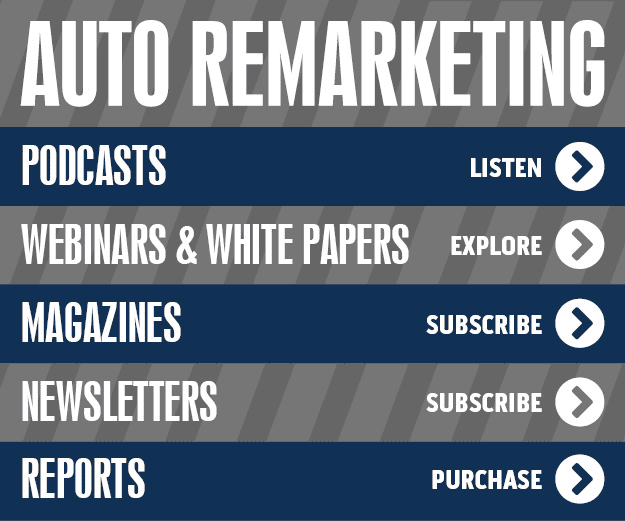Black Book released the results of its Mobile Usability survey, which takes a deeper look into how industry professionals use mobile technology in their day-to-day business.
Auto Remarketing previously spoke with Mike Williams, the vice president of mobile and direct sales at Black Book, to get a forward glance at the study’s results. The majority of the more than 1,000 dealers, remarketers and other such professionals surveyed revealed that they feel more profitable using mobile technology (64 percent of those surveyed) and said the apps they rely on make vehicle valuation quicker (77 percent of those surveyed).
“While mobile technology today offers a wealth of features and benefits to industry professionals, it has to show that we can make profitable decisions faster,” Williams said in Black Book’s release. “And the speed at which mobile apps like Black Book Digital perform, can eliminate critical seconds when accessing valuations, vehicle scans and history reports.”
Here’s a breakdown of the survey questions and results, according to Black Book:
How much more profitable do you think you are using a mobile app?
- Equally profitable (31 percent)
- More than 10 percent (30 percent)
- 1-5 percent (19 percent)
- 6-10 percent (15 percent)
- Less profitable (3 percent)
How much faster can you value a vehicle using a mobile app?
- 20 or more seconds faster (53 percent)
- 10-19 seconds faster (15 percent)
- Equally fast (14 percent)
- 5-9 seconds faster (9 percent)
- Not faster (6 percent)
Which area does mobile help you most?
- When buying at auction (56 percent)
- When appraising a trade-in (39 percent)
- When selling retail (2 percent)
- When selling at auction (0 percent)
- I don’t use a mobile app (0 percent)
What features do you use the most on your mobile app? (Choose as many as apply)
- Valuation and appraisal research (30.9 percent)
- VIN Scan (30.7 percent)
- Vehicle history reports (15.0 percent)
- Market Report (7.3 percent)
- Other (7.2 percent)
- Q-list/Wish list (5.4 percent)
- Determine demand for vehicles selling in specific regions (3.4 percent)
- Sharing vehicle information with colleagues, other dealers or retail customers (0.0 percent)
Reader feedback for our previous story on this topic shed light on the opinion that some new technologies may be making people in the industry a bit lazier. And, according to our previous interview with Williams, that is a suggestion that’s not too far from the truth.
“At this point you can sit down in front of a computer, you can be in four different auctions, you can be looking at two or three different dealer networks, all at the same time,” Williams said. “You can be pulling the trade-in value and see what they’re going for on all these networks. I don’t want to say anything provocative, but you’re now in a better position not to go anywhere than you ever have been.”
This lead to a question about the importance of the physical auction setting, where many in the industry swear by the relationships they’ve grown and fostered in person while bidding. Williams believes that side of the auction system will always have a place.
“The reality is there’s always going to be a core group of guys,” Williams said. “And I think every dealer enjoys a good auction. It really is a carnival, it’s a fun atmosphere; there’s a lot going on. I think that while they’ve slowed down their number of visits per year, the reality is they’re always going to go there. They’re always going to visit their IADA convention and things like that. And they’re going to have opportunities to intermingle with other dealers.
“I don’t think, in the end, we’re ever going to see the end of the auctions,” Williams continued. “But I think we’ve already seen one evolution of them, which is now most guys at the auction, if they’re not on the mobile themselves, they have a second spotter out on the lot who’s checking the information. They’re communicating back to the dealership. We’re already getting this hybrid where they’re not just online and they’re not just in the lane. There are a lot of guys who will bid on 4 or 5 different sales at the same time from home base while they’ll have guys out there on the lot checking the vehicles.”
What do you think? Do you prefer to go to the auction in person or do you find more value in bidding remotely? Or a mix of both? Let us know in the comments or tweet us @autoremkting.
Insurance Auto Auctions announced Wednesday the launch of a new feature for its CSAToday app for iOS.
The feature, Vehicle Assignment, is the first mobile vehicle assignment feature on an iOS device for the salvage industry, the company reported.
Vehicle Assignment allows customers of CSAToday “anywhere” access to begin an assignment with IAA while also improving its capabilities through GPS location.
“We focus on developing technology that best serves our customers, who are on-the-go and value flexibility and efficiency,” John Kett, IAA’s president and chief executive officer, said. “The mobile Vehicle Assignment feature further exemplifies IAA’s continued commitment to building innovative solutions for our customers.”
The Vehicle Assignment feature streamlines the process into a “five swipe” workflow – each of the five sections focuses on only required fields, which users swipe through to complete information on the seller, owner, vehicle, location and pickup. The feature also utilizes the iPhones camera for scanning VINs and its GPS for location entry. It can also use the phone’s dispersal tools, as well, including text, email, print and AirDrop.
CSAToday by IAA can be downloaded for free on your mobile device from the App Store.
Cox Automotive announced this week the integration of two of its dealer management tools. With this integration, data from VinSolutions CRM can be accessed via the vAuto Provision suite, helping dealers make better inventory management decisions while using Provision.
Randy Kobat, the vice president and general manager of vAuto, believes the integration will be mutually beneficial for users of both tools.
“Our shared vAuto and VinSolutions customers can get a powerful new advantage with this integration,” Kobat said. “Dealers have the opportunity to apply the unique insights from their own shoppers in addition to the already comprehensive market data in the Provision system — giving them the right information in the right context at the right time to make better used vehicle appraisal, acquisition and pricing decisions.”
According to Cox, the enhancements to Provision are:
- The Pricing module can display the number of active leads for every vehicle in a dealer’s inventory, providing dealers with the ability to make real-time pricing decisions in the context of real-time customer demand.
- The Provisioning module can identify when vehicles that match the dealer’s stocking strategy are scheduled for service appointments, giving dealers the opportunity to present timely trade-in offers and acquire needed inventory.
- The Appraising module will notify dealers when they are appraising vehicles that appear on their shoppers’ wish lists, allowing them to appraise and acquire with the confidence that there is a buyer for the vehicle.
“The point of integrating this data is not just to provide dealers with more information, but rather to give them more insights that they can act on immediately,” said Sean Stapleton, the vice president of sales and marketing at VinSolutions.
KAR Auction Services’ business unit ADESA announced this week the new fee structure for open sales on DealerBlock. Those using the company’s 24/7 online marketplace for bid-now events or buy-now inventory should expect to find the fees, in effect for the fourth quarter, to be simpler to calculate and, in some cases, lower.
Stephane St-Hilaire, ADESA’s president and chief executive officer, believes dealers will be pleasantly greeted by the program’s new fee system.
“We are always looking for ways to make working with us simpler and more profitable for our customers,” St-Hilaire said. “In almost all cases, dealers will be paying less with the fee structure.”
The temporary pricing structure went into effect Wednesday and will remain in place until the end of the year on Dec. 31. The same price will be paid by all buyers based simply on the purchase prices alone.
There was a small concentration of vehicles that GE Capital Fleet Services found challenging to sell earlier this year. So, in response, the company launched an incentive package for its online wholesale buyers, through which if a buyer purchased three of those vehicles, he or she would receive a buyer’s fee discount that GE Capital Fleet Services would pay for.
“The fee discount brought more and more buyers to our vehicles, which resulted in more vehicles sold,” said Paul Seger, vice president of asset remarketing.
When that incentive package was launched, Seger said, the company saw an “immediate impact.”
Such an approach has been part of the company’s focus this year: incentives to drive online buying and thus increase the prices in the lane.
All vehicles in its consignment are offered first in an open, competitive-bid auction process with online dealer influence, meaning all vehicles they sell in the lanes have dealers bidding via Simulcast or LiveBlock technology connected to that sale.
Seger said in a July interview that at that point, online lane buyers had increased by roughly 5 percent year-to-date.
“The more buyers you can get online to actually bid on the vehicles drives up the prices,” he said. “We’ve actually been very aggressive this year with buying incentives focusing just on online buyers.”
GE Capital Fleet Services has also continued to hold large volume event sales in the physical lanes, with as many buyers online as possible, as well, to drive demand.
Typically, GE Capital Fleet Services will end up selling nearly 90 percent of the cars it consigns. But it does have a strategy should any of its offerings not sell at the auction.
“When it comes to those that we don’t sell, it may be that we didn’t have the right buyers or the right number of buyers there, but we know we had a benchmark run from what that vehicle brought that day,” Seger said.
“We might have wanted $10,000 for that vehicle, but that particular day, we received $8,500. My team will take those vehicles, and they’ll price them somewhere between $8,500 and $10,000. They will then post those online at a buy-now price, but only after it’s crossed the block in a competitive bid environment,” he continued.
“We feel that’s a really good way for us to protect our customers’ returns. If you just put your vehicles up online first, the ones that are probably going to buy are the ones that go over your floor price in the lanes, anyway,” Seger added. “This way we’ve researched it a little more; we’ve run them in the lane; we know what the market brought, which all leads to maximizing the net returns for our customers.”
Editor's Note: This story is part of our Top Fleet, Lease & Rental Trends coverage in the Sept. 1 print and digital editions of Auto Remarketing.
Dealers, it seems, are exploring a bevy of alternative avenues to acquire used-vehicle inventory like dealer-to-dealer trade networks, online auctions and multiplatform remarketing, as well as websites where they can generate trades directly from consumers.
At the same time, more traditional routes like working the trade-in and the brick-and-mortar auction sales are a strong mainstay for dealers to find used cars — the ladder being particularly evident in numbers provided by the National Independent Automobile Dealers Associations’ 2014 Used Car Industry Report.
But the thread that has tied these used-car acquisition techniques together is the savvy use of technology — be it in the lanes at the auction, through an online remarketing portal or generating a trade from consumer — to make used-car acquisition more efficient for the dealer.
And perhaps it’s no coincidence this run-up in acquisition ingenuity from dealers, auctions and third-party providers has occurred at a time where used-car supply has gone through sloping ebbs and flows stemming from the drought of new-car sales in the recent recession and the subsequent onslaught of success in both the new- and used-car markets.
In other words, the industry as a whole responded to the supply waves by ratcheting up innovation.
Where the Used Inventory is Being Found
Just five years ago, 14 percent of auction sales were Internet-based, meaning they were done either by simulcasting or completely online. In 2013, that share shot up to 17.4 percent.
Those numbers were included in the 2013 National Auto Auction Association Annual Review, which accompanies the NIADA report mentioned above.
NAAA indicates that online-only auction sales have seen particularly strong growth in the last five years, climbing from a 2.7 percent share in 2009 to a 4.7 percent share in 2013.
Simultaneously, more than 92 percent of respondents in the latest NIADA Member Survey say they turn to the auction to find inventory, while more than half of NIADA members surveyed mentioned other dealers (53 percent) as an inventory source, a third cited wholesalers (32.4 percent), more than a quarter go online to find used cars (28.7 percent) and 58.4 percent pointed to other measures.
(Respondents could choose more than one answer, so numbers add up to more than 100 percent).
More than 39 percent of respondents in the same NIADA Member Survey say they go to the auction one to four times per month and over a third (33.6 percent) go to an auction eight or more times a month. Roughly a fifth (19.5 percent) say they attend the auction five to seven times a month and less than 8 percent don’t go to the auction.
On the franchised dealer side, the NADA DATA 2014 report from the National Automobile Dealers Association indicated that among used cars retailed by dealers last year, 41 percent were sourced from a trade-in on a new vehicle. Twenty-five percent were sourced via trade-in on a used car, and another 25 percent were bought at auction. Five percent were street purchases, and 3 percent fell into the “other” category.
For more details on how dealers are using technological advancements to shore up their used-car supplies, stay tuned to the Aug. 15 edition of Auto Remarketing. The digital version of this magazine is set to hit email inboxes Tuesday and can also be found at digital.autoremarketing.com.
KAR Auction Services already shelled out $30 million to acquire a 50-percent stake in online vehicle remarketing system, TradeRev. And investment analysts wondered if KAR is ready to bring out the company checkbook or credit card again to buy the remainder of Toronto-based wholesale solution firm or another company outside of its current portfolio of ADESA, Insurance Auto Auctions and Automotive Finance Corp.
While also reminiscing about his franchised dealer days when discussing TradeRev, chief executive officer Jim Hallett mainly kept company strategy close to the vest when KAR conducted its quarterly conference call this past Wednesday.
“We do have other deals in the pipeline in our other businesses as well, but nothing that we're in a position to discuss today,” Hallett said during his opening comments of the call that later consisted of plenty of discussion about how TradeRev and ADESA can boost both service for dealers and profits for the company.
Later, Hallett touched on the acquisition issue again when questioned by the investment community, which cheered the company’s overall second quarter performance that included increases in revenue, adjusted EBIDTA, net income and adjusted net income.
“In terms of other acquisitions, I think we're always looking at different businesses, how they fit both from a strategic standpoint, as well as how they might fit from a technology standpoint, and then perhaps the geographic standpoint. We're evaluating these businesses … one at a time,” Hallett said. “We prioritize them. They don't always go down as we think they’re going to go down.
“But at the end of the day, there are a number of businesses that we continue to focus on that would tuck-in very nicely,” he went on to say.
Besides the solution’s wholesale market capabilities, KAR chief financial officer and executive vice president Eric Loughmiller pointed out valuable parts of the TradeRev acquisition deal are the possibility that KAR can acquire the remaining ownership portion as well as keeping the previous management team in place — similar to the strategy when KAR bought OPENLANE.
“We have some rights at the right time to perhaps increase our ownership. And we'll see how that plays out,” Loughmiller said. “And at any point in time, you can always buy the rest of it if they’re willing to sell it at the right price, right? But being part of this it's really important to us in keeping the management team in place, the founders and their technology skills and their knowledge of the market.”
Hallett elaborated about the value of TradeRev’s management, which includes president and founder Mark Endras.
These guys first got started in 2009, so this is technology that they've been working on and developing and have learned a lot of lessons as they’ve developed it,” Hallett said. “And it was really critical for us to keep them in the deal. Keep the founder in the deal, and he kept his entire management team in place. I think that's what they bring to the table,
“From the ADESA side, when you think about our locations and our people and our resources, we can really pour the gasoline on this thing and get it to the market and hurry,” he added.
ADESA already entered into a joint marketing agreement with TradeRev to assist in expanding its footprint in the dealer-to-dealer online space in the U.S. and Canadian markets.
The company highlighted ADESA will be the exclusive provider of certain products and services to TradeRev’s customers. Officials added that ADESA will also leverage its 65 auction locations across North America and the company’s strong online auction presence and dealer network to support TradeRev’s diverse dealer offerings.
“TradeRev is a company that we identified that was operating in Canada. We thought it was a unique business model, and saw that it was focused on what I would call an addressable market that we currently didn't feel that we were getting a slice of. It was just opportunistic that we got involved in conversations, and we ended up acquiring 50 percent of the business. It was really the strategic rationale of bringing this component of the business into the KAR family,” Hallett said.
“I believe that the combination of TradeRev and ADESA will create opportunities to expand our buyer base throughout the entire organization,” Hallett went on to say. “TradeRev creates private, customized network of buyers and sellers to move fresh trades. TradeRev is a solution that addresses the 20 million units to 22 million dealer-to-dealer transactions that don’t currently come to a physical auction. We estimate that as many as half of these vehicles are sold on a dealer-to-dealer basis, and what TradeRev will do is TradeRev will stand in the middle of these transactions much like we do in our online and physical auctions.”
Since Hallett is a former dealer, he also described how TradeRev is a solution geared to make things easier for busy managers. Dealers can get started by scanning the VIN and taking a few pictures with their mobile device. Then, the auction process is in motion.
“Dealers are going to have the ability to close more sales because they're going to have stronger appraisals on these cars. And they're also going to reduce the risk of loss at the time when comes to selling those trade-ins,” Hallett said.
“And I can tell you that, as a former franchise dealer, I would absolutely love to have a tool like this,” he continued. “When I think about my time and the efficiency that I spent calling wholesalers and trying to get bids and trying to get appraisals on cars, and then when I think about the lost opportunities, the number of deals that I wasn't able to close because I wasn't able to get what I would call an accurate appraisal on the car, certainly it prevented me from getting some deals done.
So, with TradeRev, I think this is a good example of the type of strategic growth that we are pursuing,” Hallett went on to say.
Copart has invited the general public to vote on the finalists of its first Copart Rebuild Challenge.
The contest, which gathered video entries of various vehicle rebuilds from April 14 through July 6, has been narrowed down to 10 finalists. The three with the most votes by July 25 will receive one of three prizes: a $10,000 grand prize, $2,000 second-place prize or the third-place reward of one year of Copart Premier Membership.
Matt Burgener, the chief marketing officer at Copart, was elated to view the variety of entries his company received.
“We had an overwhelming response to the Copart Rebuild Challenge,” Burgener said. “Our members fixed up everything from luxury cars to boats and motorcycles. It was wonderful to see how talented our customers truly are. We are excited to get the public involved to vote for their favorite video and ultimately select the winner of our inaugural Copart Rebuild Challenge.”
To view the ten finalists selected by Copart’s panel, click here.
The number of cars sold by Toyota Financial Services on OVE.com in 2013 was the highest annual sales tally any one customer has ever posted on the remarketing website.
And TFS was honored accordingly, as it recently received the OVE.com Highest-Volume Seller Award for 2013 from Manheim.
Michael Reid, national manager of Toyota Financial Services/Lexus Financial Services Remarketing, accepted the award in June at LFS offices in Torrance, Calif.
“It is an honor to be recognized by both Manheim and OVE.com, two of our company’s great auto remarketing partners,” said Reid. “Our company counts on OVE.com and Manheim to help us to provide solutions, deliver results and sell vehicles.”
Allan Wilwayco, general manager of Manheim Digital Marketplace, added: “Toyota Financial Services is our largest seller on OVE.com.
“TFS has set the standard for digital remarketing, while establishing a transactional market that provides above-average retentions,” he continued. “TFS is an excellent partner, and is a leader in the industry.”
ADESA this week announced continued benefits to registered dealers who purchase vehicles online, via the implementation of various new products and services.
ADESA’s High Bid Wins program, for example, makes it easier to purchase dealer-consigned vehicles online by setting an opening price at reserve for all off-site dealer-consigned vehicles available on ADESA.com.
“This program offers transparent pricing for dealers and that customers will receive their vehicles in a timely manner,” said Tim Zierden, ADESA senior vice president of dealer services.
“High Bid Wins gives buyers more confidence that the time they spend placing bids will result in purchases, not negotiations,” he said.
Another online program aimed at boosting buyer confidence is ADESA’s Enhanced vehicle listing category.
In this program, select vehicles purchased on the company’s online buying platform, ADESA DealerBlock, will now be sold with an enhanced arbitration policy.
“The enhanced vehicle listing category gives buyers further peace of mind when purchasing vehicles online,” Zierden said, “and allows them to source more of the types of vehicles they need for their unique inventory mix.”
Enhanced vehicles on ADESA DealerBlock are marked by a special “E+” icon designation.












